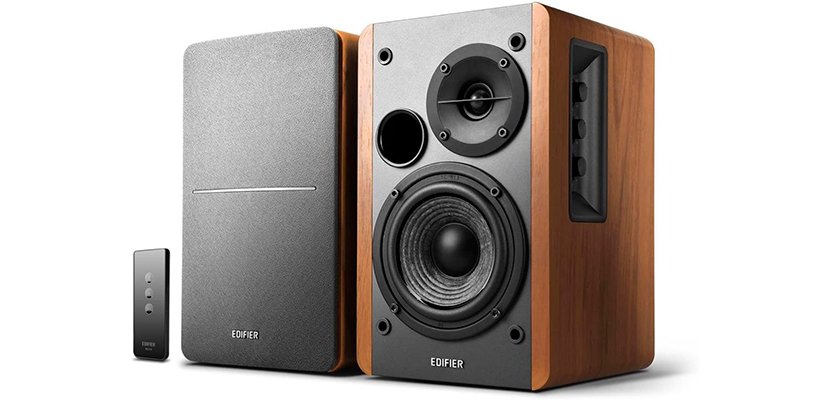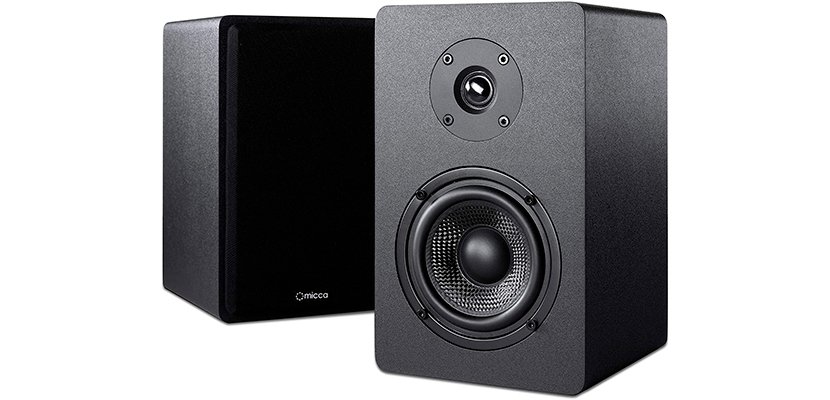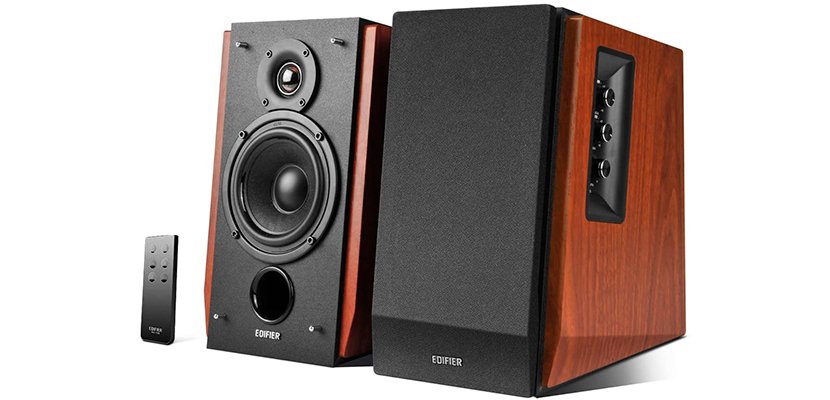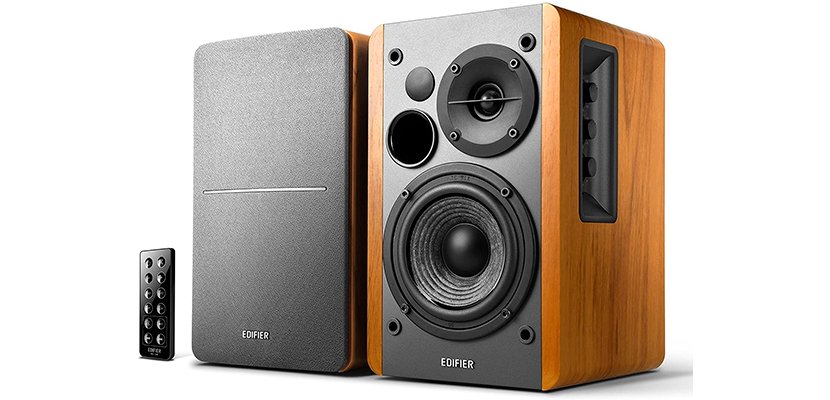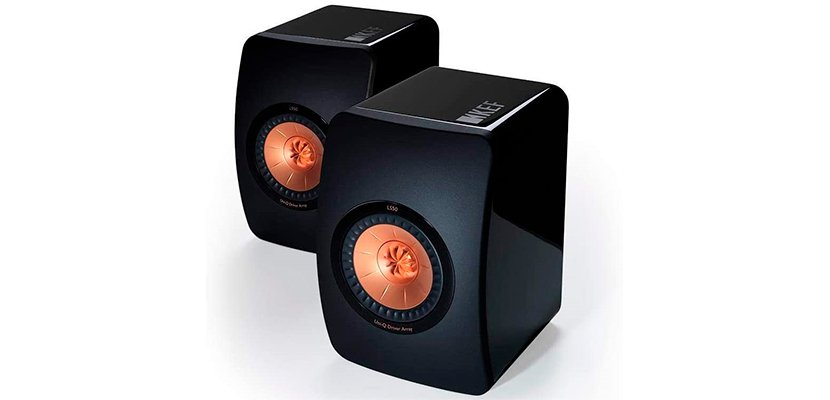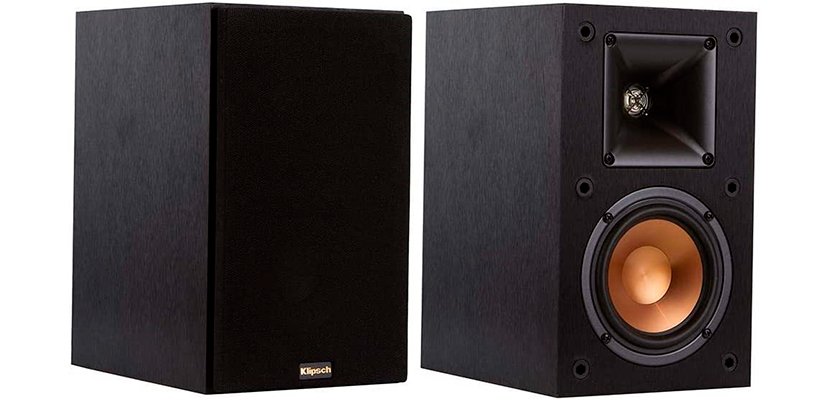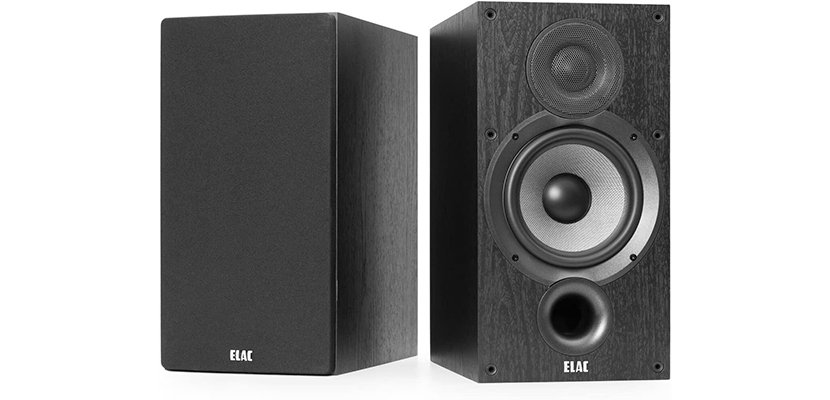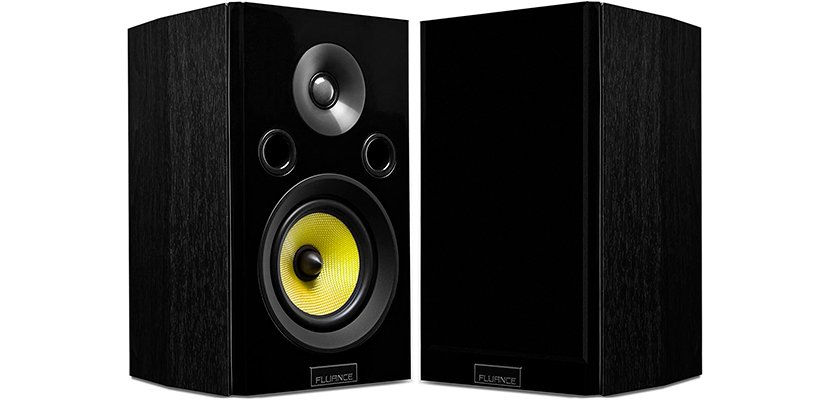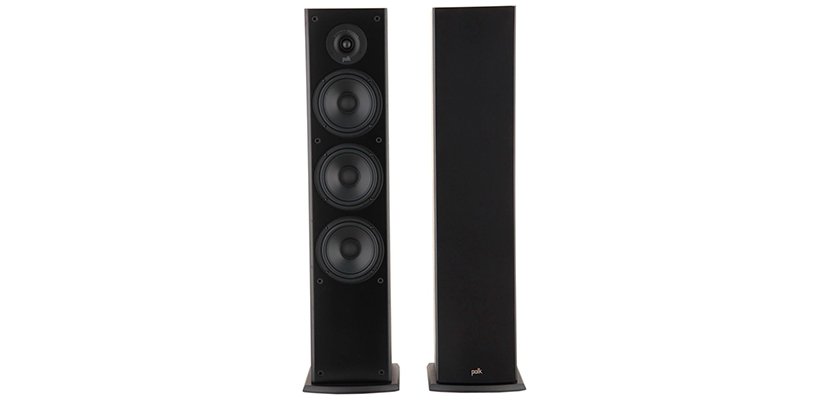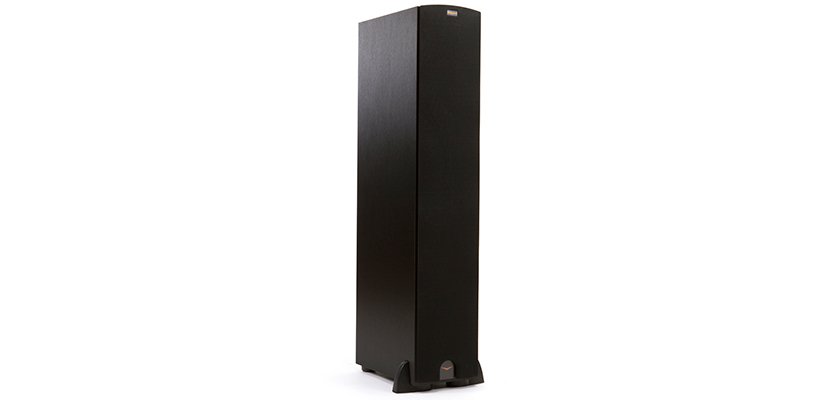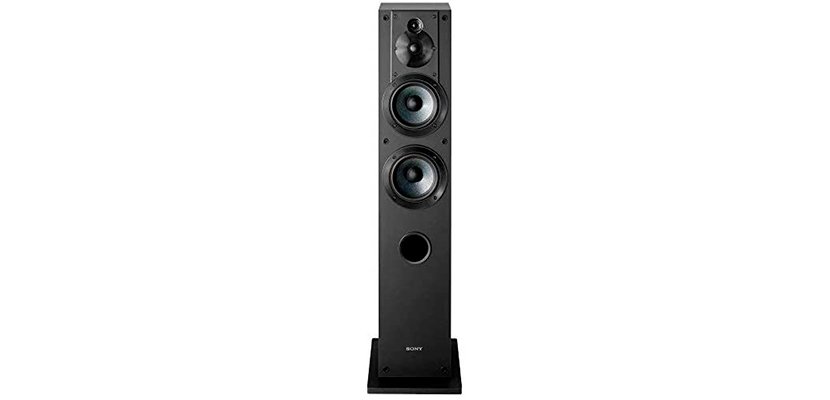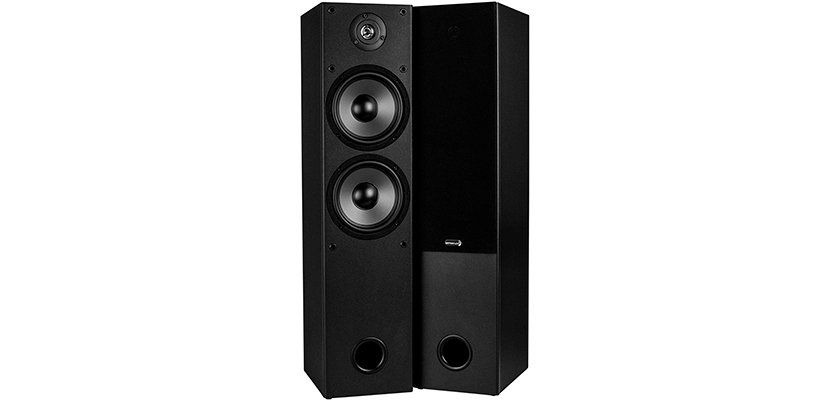People revive vinyl industry because of a warm and textured sound. Record players magically emerge in homes around the world, and today nearly 90% of the best speakers for vinyl players are used by true music lovers.
Bookshelf speakers usually come in a compact form factor that can be mounted on a rack or located on a small shelf. These loudspeakers are usually 2-way, and sometimes 3-way, consisting of the tweeter, midrange, or treble speakers. Sometimes such devices can contain one coaxial or wideband (+-HF) speaker. They often have limits in bass because of their small form factor but still, are able to impress the person with deep sound.
Floor acoustic speakers are usually large enough to stand without additional props installing. They often contain multiple drivers with specialized bass (woofer) driver, midrange driver, and tweeter. Such products usually have more powerful bass and can play louder than similar bookshelf variants.
When deciding to buy the best speakers for turntable, ask yourself the following questions:
- How much money do I have?
- Am I looking for quality sound with medium/high frequencies, soundstage, or just want to enjoy the loud sound with a lot of basses?
- Can I place bookshelf or floor acoustics in my room next to the vinyl player?
Don’t forget that the bookshelf products better fit small apartments, while the floor variants can become a great solution for big rooms. Compact elements are cheaper than the big models. Moreover, the first speaker’s type can be active and passive, while the second models are almost always passive and need an AV receiver or amplifier with a “phono” input. Let’s get acquainted with all these details below.
Speaker for Vinyl Reviews
Bookshelf Speaker
Some bookshelf models immediately occupied TOPs, others gradually won the hearts of listeners. Some had an aggressive marketing policy; another became popular thanks to the recommendations of the owners. It’s rather hard to make the right choice. While looking through active and passive sound devices, I have chosen some worthy options to help find the best bookshelf speakers for vinyl.
Active Bookshelf Speakers for Vinyl
Edifier R1280T — Best Speakers for Vinyl Under $100
This model has 42W output, are 9.5 inches tall, 5.8 inches wide, and 6.9 inches deep. Still, with the retro-style aesthetics and high-quality build, they deserve to be put in front to be seen well. The retro looks, though, isn’t the sole reason to call this unit the best powered speakers for a turntable. They provide versatile connectivity with dual RCA ports and feature some tonal balance controls to adjust the sound to the listener’s individual taste. However, this device don’t feature Bluetooth or other wireless connectivity.
The housing is performed with precision, the finish and all angles are smooth, the controls and connections are within reach and have sturdy dials / jacks. I appreciated the dual RCA inputs and the AUX port that I used to plug in my phono and headphones. Setting up the system is easy, the speaker connections are simple and straightforward. Especially since all cables are packaged.
Detaching the front grill, I’ve found a 4-inch woofer and a 0.5-inch tweeter with the cross beam. I had to make the minimal adjustments to get the full warm analog sound with the lively dynamics and vast frequency range that did correspond with my perception of the best budget powered speakers for a turntable. The highs were sharp at peak moments but not shriek. The mids were articulate and harmonic.
Pros
- Even frequency response without cutoff issues.
- A well-adjusted flared port reflex ensures smooth soundflow.
- Volume can be regulated and muted through the slim remote.
Cons
- At a low volume level, the bass tends to roll off.
- Tonal controls act only in the -6dB to + 6dB range.
Micca PB42X — Best Powered Speaker for Vinyl
The active speaker system produces rather balanced and not V-shaped muddy sound. This item is well made, includes acoustic fiberfill and a clean crossover. On the contrary, the corps is light so it can resonate at higher volumes. It’s better to put a heavy book on top of device while listening to the loud hard-rock music. It’s easy to connect RCA speakers for turntable due to mentioned plug and 3.5mm input jacks; moreover, this model can surprise you with high notes sounding because even falsetto voices don’t distract. It’s hard to call the Micca the best speakers for vinyl under 100 dollars, but it is undoubtedly an agreeable variant.
Pros
- The system has a decent bass response even without a subwoofer.
- The assembly quality raises no issue.
- Magnetic removable speaker grill makes Micca PB42X look very modern.
Cons
- The sound becomes downward because of the ODAC using.
- It’s hard to reach the power switch and volume controls because they are placed on the rare side.
Edifier R1700BT — Best Bluetooth Speaker for Vinyl Records
These speakers reproduce the sound signal with high fidelity, which is great for the rich vinyl sound. The 66W RMS capacity lets balance the frequencies efficiently and produces a wide and deep soundstage with exact imaging of instruments and vocals. I also enjoyed the unit’s performance on my old jazz albums with the exact transmittance of the complex dynamics.
The Edifier R1700BT sounded confidently in any music genre, from classic rock to country tunes. The maximum output of 135W did help a lot during bass peaks when the oboe and drums had their own distinct lines yet were blending harmonically with the main line. The midrange is represented by the wide frequency scope with a lot of detail. The treble is airy, with the well-drawn instrument and voice lines, and free from overly pitched performance. The tonal balance is neutral, the response is smooth throughout the range.
This model has two sets of RCA inputs (for multiple connections including the phono stage) and the single speaker out port. There’s also the on/off switch and the hardwired power cord. The volume, bass, and treble controls are positioned on the side and are quite sensitive. The volume can also be controlled via the slim minimalist-style remote. The latter also helps mute the speakers with a single button or activate the Bluetooth / RCA input. The latter enables pairing device with the smartphone or another wireless device or listening to music via the Bluetooth headphones.
Pros
- Built-in DSP and DRC cut the electric interference efficiently.
- The volume button is pushable for additional functions (BT pairing, input switching).
- Stylish slanted front design and the wood resembling walnut finish make this model fit various interiors.
Cons
- No password / restriction for Bluetooth connection.
- No coaxial / optical ports that present in the competitor models.
Edifier R1280DB
For vinyl beginners and professionals, this acoustic set provides a lot of versatility and comfort of use. It combines multiple functions and connection ports including wireless connection. With its classic wood grain looks, it will fit any turntable setup while providing a precise signal output with a good amount of detail.
The material base of the Edifier R1280DB is similar to other devices made by this brand. It integrates a 4-inch woofer that produces a nice slightly rounded bass with good dynamics. The midrange is open and detailed, the separation of voices and instruments is distinct, and each line is represented fully. The 13mm tweeter features the silk cone and brings bright treble, which sometimes borders on with dryness. Still, the overall performance is transparent, transmitting a lifelike sound.
The tweeter’s and woofer’s levels can be tweaked up to the 6dB range. Controls are built into the side of the active speaker box. The volume button also serves as the input switch. The volume regulation including the “Mute” button are also represented on the remote control.
Each speaker has 21W RMS output and is connected through the spring-loaded terminals. For the external hookup, there are two dual RCA sets for the turntable connections. It also has coaxial and optical inputs. The Bluetooth is also a good option for those who like to use their bookshelf speakers for music streaming.
Pros
- The sensitivity is above 85dB providing for the clean loud sound.
- Input switching is fast and interference-free.
- The remote features the playback controls as well.
Cons
- The low frequencies start with 55Hz; the bass might be missing in the hard rock compositions.
- The LED indicator is located on the side and is non-visible on many occasions.
Passive Bookshelf Speakers for Vinyl
KEF LS50
The KEF LS50 bookshelf passive speakers system has impressive miniature dimensions. Its thick walls made of MDF ensure the high-quality acoustics and excellent antiresonant properties, contributing to the natural sound formation. The Uni-Q 5.1-inch driver, which is responsible for medium and low frequencies, and the 0.9-inch tweeter are located in the center of the radiator. Suspension of mid/low-frequency emitter is elastic, which allows the system to form a dynamic scene with a well-detailed middle and deep bottoms. It’s very strange that such small units are so heavy (15.87 pounds).
Pros
- Devices’ open-ended acoustic design recreates surround sound with rich bass.
- The cylindrical phase inverter tube has a specific form, so it reduces the level of transverse resonance during the work process.
Cons
- The corps is too glossy, and it’s easy to see the fingerprints and even small scratches on it.
- Top frequencies are able to cause ear fatigue.
Klipsch R-14M
The exclusive technology of trumpet loudspeakers and tweeters provides high-class response, powerful dynamics, and natural sound. The passive speakers can boast with high sensitivity, small sound distortions, controlled radiation pattern, smooth frequency response, wide dynamic range, and other extra features. Additional amplifier with “phono” plug helps connect the devices to the vinyl player easily. Apart from the good elements, it needs to mention the lack of power in sound. The produced music is rather weak, and sometimes I even have to tune in to the track to get all the musical effects. The maximum volume isn’t enough for rocking the room, so the Klipsch product isn’t the best turntable speakers for big parties, but it is a not bad option for small companies.
Pros
- This model has a classic 2-way configuration and are able to fill with the sound a small or medium-sized room.
- Seamless integration of low-frequency woofers with IMG technology complements the sound of dense bass with minimal decay.
Cons
- I found a small crack on the body, which indicates the bad-quality corps material.
- It’s hard to connect this device to the vinyl player. The device refuses to accept new facilities and starts cooperating after the few repeated attempts.
ELAC Debut DB62-BK
The revised mid/woofer provides an excellent level of detail in the upper bass and doesn’t sound light. A very old vinyl record can become a reason for a little bit annoying screech appearing. Some high notes are reproduced too strident. At the same time, passive bookshelf speaker system brings the main vocals to the most advanced sound stage and makes the leading instruments bright and alive. The durable MDF case with elegant black ash finish has increased volume, stiffness, and durability. The frequency range up to 35000Hz provides very high realism, so these models are one of the best budget speakers for vinyl, which can present such a frequency response.
Pros
- Define waveguide improves directional control and eliminates diffraction inherent in most corps.
- The port is on the front side, so the placement is much easier.
Cons
- While listening to jazz and soft rock, I can’t feel the depth of soundstage.
Fluance Signature HFS
I like the ultra-high-end Neodymium tweeters presence because these elements in speakers make the vinyl player sound very clear. The passive units are not the best speakers for vinyl record player, but they look amazing and able to make the sound move in a multi-directional way; I mean that even after placing the elements near the listener or behind him/her, the sound will be enveloped. The peculiar midrange pointed dome creates the feeling of being in front of the stage with musicians. The insufficiently deep bass is an unpleasant surprise for me because the rock music via vinyl player has lost its deepness and doesn’t seem to be impressive.
Pros
- Build quality is excellent. The corps is made of an engineered dark wood, which makes the devices very light.
- The manual has all the important data and it is easy-to-understand.
Cons
- This model need a break-in because after the first usage the sound is awful.
- The system becomes very hot in a short period of work.
Floor Standing Speakers
Polk Audio T50
With the 9.25 x 8.75-inch base and 36.5-inch height, these towers from Polk won’t take much space but bring the enveloping sound with the solid lows. I appreciated the high sound clarity that didn’t change throughout the volume rising up and raved at the accurate frequency response. But for the passive character of these speakers (entailing the need for the amplifier and resulting in no direct hookup to the vinyl record player), I’d confidently put this model among the best floor speakers for vinyl.
The tower speakers are made of thick MDF with a smooth matte finish and provide a stable base for sound without interference. The drivers are reliably fixed within the box and don’t provide vibration even at a high load. The maximum output of the set makes 150W. The midrange and lows are handled by the 6.5-inch woofer, the sub-low frequencies are reproduced through the two bass radiators below. The tweeter has a 1-inch diameter and provides clear and detailed voices. The mids are well audible and deep, with high dynamics and a wide spectrum of frequencies. The bass is surrounding, with a confident thump and growling reverberance.
This model can also be used for multiple home activities. They can be the base of the surround sound system or serve for the video game audio transmission. They provide the stereo sound and can be used in various sound sets like 2.0, 7.1, or 9.1 systems.
Pros
- The Dynamic Balance technology is integrated into all drivers creating a precisely balanced output.
- The extended range of 38Hz to 24kHz brings up the highly articulate sound on all frequencies.
- Sturdy gold-plated binding posts for speaker connections.
Cons
- The 6-Ohm impedance limits the range of compatible amps and receivers.
- The bass radiators are passive.
Klipsch R-26F
Hooking up the R-26F to the phono stage took me time as the speaker level required the thorough tweaking via the connected receiver. Still, other than that (and the fact that for the price, you get a single speaker instead of a pair, as with many competitors), I would say this is one of the best speakers for vinyl under 500. The performance is dynamic, the music flows naturally in any music style and genre I tried, from the opera singing to hard rock. This model fills the space immediately creating the soundstage with the thorough imaging and exact representation of each instrumental / voice line.
This brushed veneer tower will be noticeable in any design for its stylish touch and expensive-looking design. It feels solid and durable, with a 39-inch height, 7.8-inch width, and 13.5-inch depth. Taking off the mesh grill reveals two 6.5-inch woofers made of IMG and copper-clad as usual with Klipsch acoustics. The midrange produced by them is spacious and rich, with lots of detail and exact shaping of each sound line. The bass feels solid and punchy, it’s tight and rich in nuance.
The tweeter has a 1-inch diameter and is made of aluminum, enhanced with the tractrix-type cone. It produces solid highs that feel natural, without tending to the brighter or darker side. The linear travel suspension mechanism provides for the efficient distortion cutoff representing the sound in its natural way.
Pros
- 400W peak power provides a strong clear signal output.
- 5-way connection terminals ensure different hookups including bi-wiring.
- Additional front feet ensure the device’s stability and make it unique.
Cons
- At high volume, the treble occasionally becomes harsh.
- The grills are made of thin plastic and might get partly detached on their own.
Sony SSCS3
These passive products have classical Sony appearance. Black corps will make speakers the discrete elements. Devices have rigid MRC fiber woofers, which hold their shape even being under the high pressure. They don’t produce much vibration, and they stay cold even after a long working period. The 3-way 4-driver floor-standing speaker system demonstrates all the hidden sound sides and even hard music is canorous.
Pros
- Floor speakers system presents crystal-clear highs and really tight bass.
- The coherence is on high levels. Sometimes I even startle because of instruments vividness and voices sounding.
- The wide dynamic range makes the speakers produce clear music on all the volume levels.
Cons
- Some higher-frequency sounds are too uneven for me.
- When this device is turned off, it produce some barely noticeable noise.
Dayton Audio T652
This set comprises two 30-inch tall tower blocks with a slim yet solid base. The width is 7.1 inches, and the depth makes 9.5 inches. The grills cover the bigger upper half of the speaker where two woofers and a tweeter are installed.
The peak output of a pair of Dayton Audio makes 150W with quite a high 90W RMS parameter. The sound has good dynamics and balance and doesn’t get muffled throughout the frequency range. The latter starts with the audible and well-shaped 45Hz bass and reaches 20kHz for high frequencies. The woofers are 6.5-inch drivers spreading the sound with the rigid polypropylene cones. The low mids and the low-end in general is represented in detail with this model, there’s a distinct main line even in the pure bass performance. The latter gets enveloping and deep thanks to the bass reflex port providing the spacious output with distortion reduction. The bass is lively and packs a punch at peaks though might be a bit less concentrated towards the sub-low frequencies. The tweeter has a 1-inch diameter, is made of AMT, and provides open high-end.
For the analog sound, the Dayton Audio T652 provides a balanced and lively output. The instruments are pictured precisely and positioned accurately in the soundstage. Voices are sharp but overall very distinct and detailed. The volume range is quite wide letting the devices sound without any distortion and tight at high volumes (the sensitivity makes 88dB).
Pros
- High sound clarity throughout the frequency range.
- Fill the mid-size room quickly.
- The casing is thick and damps the inner vibration efficiently.
Cons
- Calibration and pairing with other devices take time, especially for the crossover level.
- Might cause the interference of the minor equipment like remotes.
Buyer’s Guide
Passive and Active: What’s the Difference?
Active speakers for turntable maintain the pre-installed power amplifier. Such a system combines two devices – the emitter and the amplifier itself. There is no need to make an additional connection between them. In practice, this means high reliability, since mentioned inner units are perfectly matched.
In passive speakers, there is no pre-installed power amplifier, the owner has to buy it and install additionally. A true music fan can purchase any amplifier and easily connect it to the speakers. The problem is that it’s hard to choose the perfect element because it can become out of order due to the increased load.
The particular features of the mentioned speakers:
- The best powered speakers for turntable (active) have a high-quality sound even at low volumes, while the passive ones will produce clean sound only on middle or high volumes.
- The passive unit’s mobility is great, but the active speakers have lighter bodies, so it’s easier to move them from place to place.
- It’s much easier to use the active speaker’s pre-installed power amplifier, but at the same time, due to the passive device, there is an opportunity to choose the necessary amplifier with “phono” input or AV receiver independently.
- The good active speakers for record player will be right for the rookies who are not professionally versed in all the intricacies of acoustic settings. However, passive acoustics systems would be great for professional musicians who want to customize the sounding completely.
Where Should I Place Speakers For Getting the Best Sound?
If the speakers are placed at a short wall, this may help emphasize low frequencies (basses), but at the same time, some unpleasant resonance phenomena can also appear, similar to buzzing rumble or ringing. These peculiarities are particularly pronounced with significant elongation of the room. In this case, the placement against the long wall is preferable. The distance between even the best speakers for vinyl (o matter of their dimensions) has to be 78-138 inches. If the units are tightly pressed to the room’s corners, the low frequencies emphasize as much as possible. If you need lower bass attenuation, you can raise the system to a certain height from the floor.
How to Connect Speakers to Turntable?
The first thing you have to do is to connect the RCA (red and white) plugs from the player’s cable to the matching RCA inputs on the speaker. The next step is to plug in the RCA connectors from the player’s cable to the included RCA (female) to 3.5mm mini-plug (male) adapter cable, making no doubts to match red plug to red plug and white to white. Then connect the adapter cable mini-plug to the speakers’ Line Level input. The last procedure is to connect the RCA plugs from the turntable cable to the included RCA to 3.5mm mini-plug (female) adapter cable. Then connect the adapter’s 3.5mm mini-plug to the powered speakers’ mentioned input cable.
Do I Really Need a Phono Preamp: What’s Its Benefit?
The problem with record players is that the signal, generated by the needle, is not so high, so the speakers can reproduce it. In other words, if you just used needle output, you would get a faint sound that lacks linear amplification. This faint signal is called a phono signal. A particular preamp can upgrade the audio system. Speakers for turntable with installed preamp are able to add individuality to the sound of the system, make the music louder and cleaner. Even pre-installed preamps are not powerful enough, so stationary variants are more useful.

Hi everyone! I’m Thomas Moody, also known as Guitarzan.

